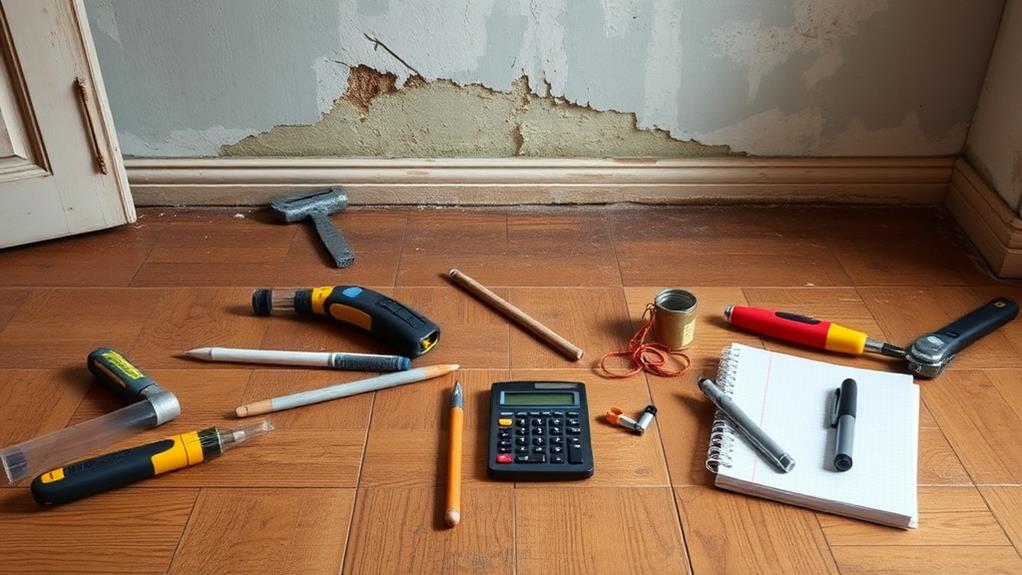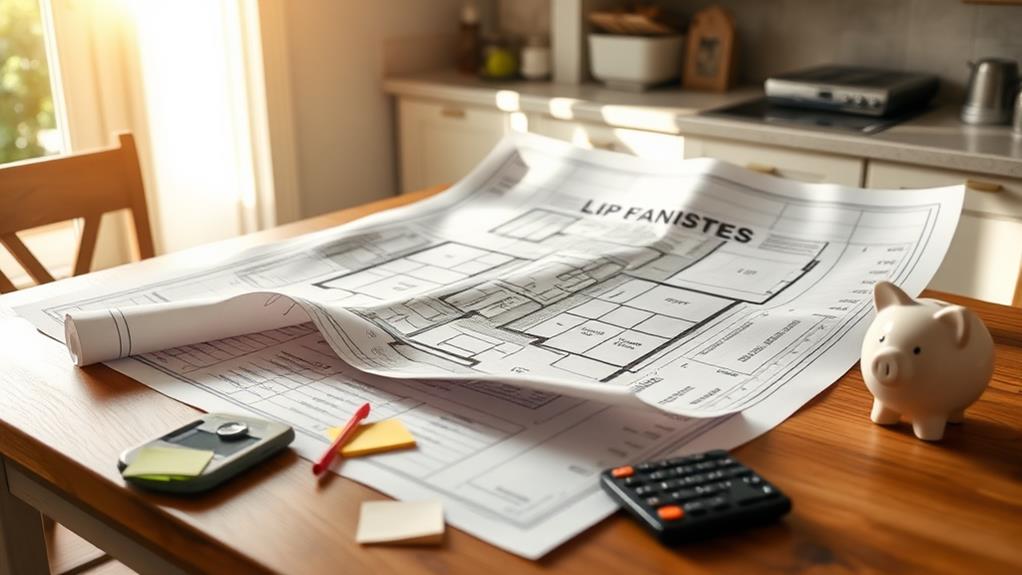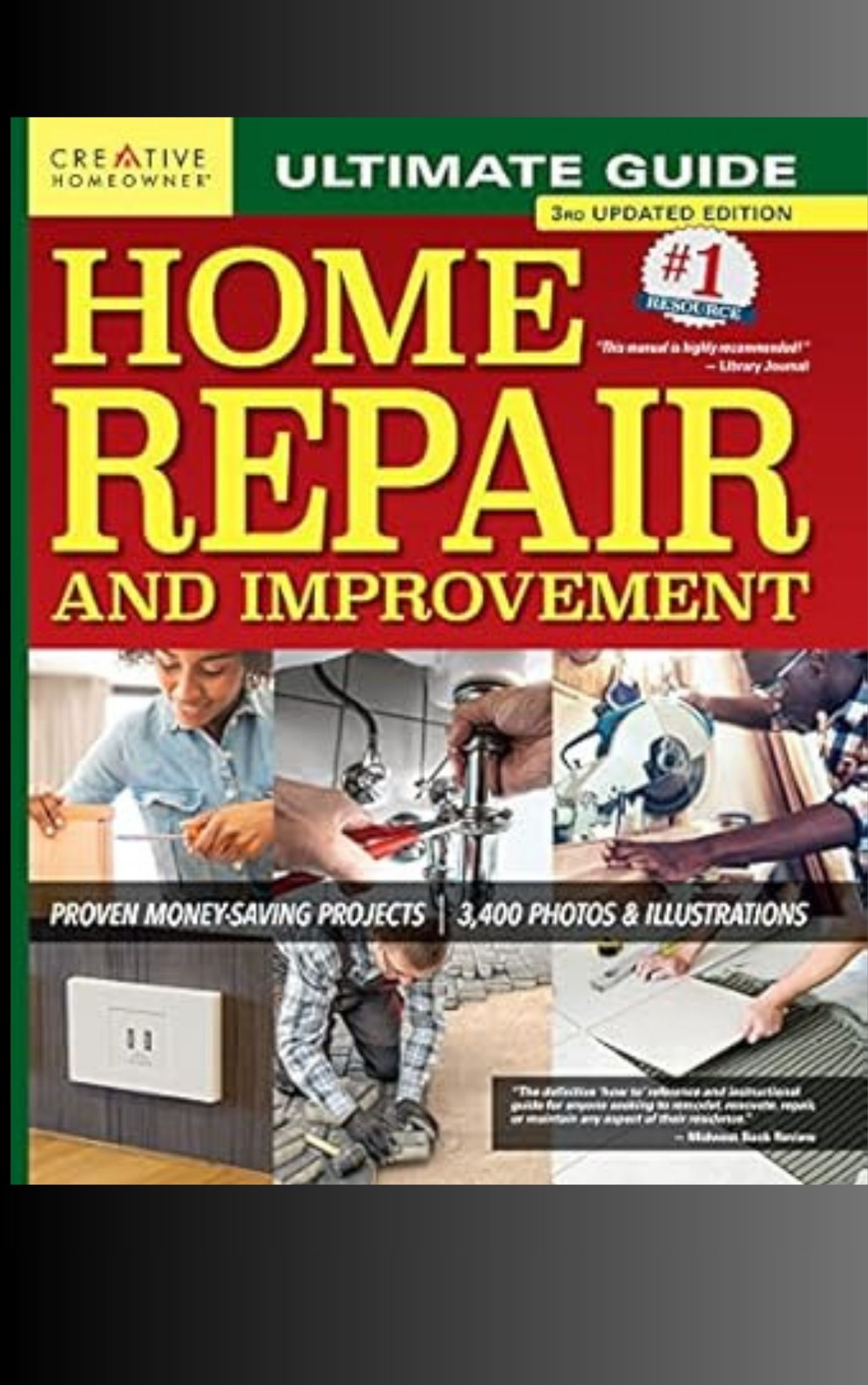When funds are limited, prioritizing renovation tasks requires a strategic approach. Start by assessing your home's current condition and identifying critical safety and structural issues that need immediate attention. Focus on essential functional repairs to ensure the property's livability. Consider energy efficiency improvements that can lead to long-term cost savings. Evaluate potential renovations based on their return on investment, balancing immediate needs with future goals. Create a phased renovation plan to spread costs over time and explore cost-effective alternatives. By prioritizing wisely, you can make the most impact with your limited budget while laying the groundwork for future improvements.
Assess Your Home's Current Condition

A comprehensive evaluation of your home's current state is the crucial first step in prioritizing renovation tasks with limited funds. This assessment should cover all major aspects of your property, including structural integrity, electrical systems, plumbing, roofing, insulation, and overall energy efficiency. Begin by conducting a thorough walk-through, taking detailed notes and photographs of areas that require attention.
Pay particular attention to safety hazards, such as faulty wiring, leaky pipes, or unstable structures, as these should be addressed immediately. Next, consider the functionality of each space and identify areas that hinder daily living or reduce your home's overall value. Examine the condition of your home's exterior, including siding, windows, and landscaping, as these elements significantly impact curb appeal and energy efficiency.
If possible, consult with a professional home inspector or contractor to gain expert insights into your home's condition. Their trained eye can spot potential issues that may not be immediately apparent and provide valuable recommendations for prioritizing repairs and renovations. This thorough assessment will serve as the foundation for creating a strategic renovation plan that maximizes your limited funds.
Identify Safety and Structural Issues
Building upon the comprehensive assessment of your home's condition, the next step is to pinpoint and prioritize safety and structural issues. These concerns are paramount and should be addressed before any cosmetic renovations.
Begin by examining the foundation for cracks, settling, or water damage. Check load-bearing walls for signs of stress or movement. Inspect the roof for leaks, damaged shingles, or sagging areas.
Evaluate the electrical system for outdated wiring, overloaded circuits, or faulty connections. Assess the plumbing for leaks, corrosion, or inadequate water pressure. Look for signs of mold or water damage, particularly in basements and bathrooms. Ensure that all stairs, railings, and balconies are secure and meet current safety standards.
Pay attention to windows and doors, checking for proper sealing and functionality to prevent energy loss and security issues. Examine the HVAC system for efficiency and potential safety hazards. Finally, test all smoke detectors and carbon monoxide alarms, replacing batteries or entire units as needed. By identifying and addressing these critical safety and structural issues first, you'll create a solid foundation for future renovations while ensuring your home remains safe and habitable.
Evaluate Energy Efficiency Improvements

Energy efficiency improvements represent a crucial aspect of home renovation that can lead to significant long-term savings. When prioritizing renovation tasks with limited funds, evaluating potential energy efficiency upgrades is essential.
Begin by conducting an energy audit to identify areas of high energy consumption and loss. Focus on improvements that offer the best return on investment, such as upgrading insulation in walls, attics, and crawl spaces.
Consider replacing outdated windows and doors with energy-efficient models to reduce heat transfer and air leakage. Upgrading to a programmable or smart thermostat can help optimize heating and cooling schedules, reducing energy waste.
Assess the efficiency of major appliances, particularly HVAC systems, water heaters, and refrigerators. If these are old or inefficient, replacing them with ENERGY STAR certified models can lead to substantial energy savings.
Lighting upgrades, such as switching to LED bulbs and installing motion sensors, offer a cost-effective way to reduce electricity consumption. Finally, explore the potential for renewable energy sources like solar panels, which may provide long-term savings despite higher initial costs.
Prioritize these improvements based on their potential energy savings, implementation costs, and available budget.
Prioritize Essential Functional Repairs
While energy efficiency upgrades can yield long-term savings, addressing essential functional repairs takes precedence when working with limited renovation funds. These repairs are crucial for maintaining the safety, structural integrity, and basic functionality of a home.
Begin by assessing critical systems such as plumbing, electrical, and HVAC. Repair leaky pipes, faulty wiring, or malfunctioning heating and cooling units to prevent further damage and ensure a habitable living space.
Next, focus on structural issues that could compromise the building's stability. Address foundation problems, roof leaks, or damaged load-bearing walls promptly to avoid more extensive and costly repairs in the future. Don't overlook water damage or mold growth, as these can pose serious health risks and lead to deterioration of building materials.
Prioritize repairs that affect daily living, such as fixing broken windows, doors, or flooring. These improvements not only enhance comfort but also contribute to the home's security and energy efficiency. By tackling essential functional repairs first, homeowners can ensure their property remains safe and livable while working within budget constraints. This approach allows for a solid foundation upon which to build future renovations as funds become available.
Consider Return on Investment

When allocating limited renovation funds, it's crucial to consider the potential return on investment (ROI) for each project. Certain renovations typically yield higher ROI than others, making them more attractive options when working with a constrained budget. Kitchen and bathroom updates, for instance, often provide significant returns, as they are key selling points for potential buyers and can greatly enhance a home's value.
Energy-efficient upgrades, such as installing new windows or improving insulation, can also offer substantial ROI through long-term cost savings on utility bills. Exterior improvements, like enhancing curb appeal with landscaping or a fresh coat of paint, can boost property value at a relatively low cost. Additionally, creating more usable living space, such as finishing a basement or attic, can increase a home's square footage and value.
When evaluating potential projects, research local real estate trends to determine which renovations are most valued in your area. Consider consulting with a real estate professional to gain insight into which improvements will likely yield the highest returns. Prioritize projects that not only increase your home's value but also align with your long-term goals for the property.
Balance Immediate Needs With Goals
Balancing immediate needs with long-term goals is essential when prioritizing renovation tasks with limited funds. Start by addressing urgent issues that affect safety, functionality, or structural integrity, such as leaky roofs, faulty electrical systems, or plumbing problems. These immediate concerns should take precedence to prevent further damage and ensure the property remains habitable.
Once critical issues are addressed, align remaining tasks with your long-term objectives. Consider how each renovation project contributes to your overall vision for the property. For example, if you plan to sell in the near future, focus on improvements that increase resale value, such as kitchen or bathroom upgrades. If you intend to stay long-term, prioritize projects that enhance your quality of life and meet your evolving needs.
Create a timeline that balances short-term fixes with long-term improvements. Spread out larger projects over time to manage costs effectively. Be flexible and willing to adjust your priorities as circumstances change. Regularly reassess your goals and budget to ensure your renovation plan remains aligned with your current situation and future aspirations.
Create a Phased Renovation Plan

Creating a phased renovation plan is crucial when working with limited funds. This approach allows homeowners to tackle projects incrementally, spreading costs over time while still making progress towards their overall renovation goals.
Start by dividing your renovation tasks into distinct phases, each with its own budget and timeline. Prioritize phases based on urgency, impact, and available resources. Begin with essential repairs and improvements that address safety concerns or prevent further damage.
Follow with projects that enhance daily living or add immediate value to your home. Subsequent phases can focus on aesthetic upgrades or long-term improvements. Within each phase, group related tasks to maximize efficiency and minimize disruption.
For example, combine electrical work with drywall repairs to avoid repeated wall openings. Consider the logical sequence of renovations to prevent damaging newly completed work. Be flexible with your plan, allowing for adjustments as circumstances change or unexpected issues arise.
Regularly reassess your priorities and progress, updating the plan as needed. By breaking down the renovation process into manageable phases, you can make steady improvements to your home while staying within your financial constraints.
Explore Cost-Effective Alternatives
Exploring cost-effective alternatives is a key strategy for maximizing limited renovation funds. When faced with budget constraints, homeowners should consider options that achieve similar results at lower costs.
For instance, instead of replacing entire kitchen cabinets, refacing or repainting existing ones can dramatically transform the space for a fraction of the price.
Another approach is to opt for mid-range materials and fixtures rather than high-end options. Many affordable alternatives closely mimic the appearance of more expensive materials, such as luxury vinyl tiles that resemble hardwood or engineered quartz countertops instead of natural stone. DIY projects can also significantly reduce labor costs, especially for tasks like painting, tiling, or installing new hardware.
Repurposing or upcycling existing items is another cost-effective strategy. Old furniture can be refinished or repurposed, and architectural salvage yards offer unique, affordable elements. Energy-efficient upgrades, while initially more expensive, can lead to long-term savings on utility bills. Lastly, shopping for discounted or gently used materials, fixtures, and appliances at salvage stores, online marketplaces, or during seasonal sales can stretch renovation budgets further.
Frequently Asked Questions
How Can I Finance My Home Renovation Project?
To finance your home renovation project, consider options such as home equity loans, personal loans, credit cards, or cash-out refinancing. Additionally, explore government-backed renovation loans, savings, or a combination of these methods to fund your improvements effectively.
Should I Hire a Professional Contractor or Attempt DIY Renovations?
Great Caesar's ghost! When deciding between professional contractors and DIY renovations, consider your skill level, project complexity, time availability, and budget. Professionals offer expertise and efficiency, while DIY can save money but requires significant time and effort.
What Permits Are Required for Different Types of Home Renovations?
Permit requirements for home renovations vary by location and project type. Common permits include those for structural changes, electrical work, plumbing, HVAC modifications, and additions. Consult your local building department for specific requirements in your area.
How Long Does a Typical Home Renovation Project Take to Complete?
Home improvement endeavors vary in duration, often spanning a delightful journey of transformation. Typically, minor enhancements may take a few days to weeks, while more extensive renovations can extend from several weeks to a few months, depending on project scope.
Can I Live in My Home During Major Renovation Work?
Living in your home during major renovations is possible but challenging. Consider factors like safety, noise, dust, and utility disruptions. Some homeowners temporarily relocate, while others adapt by living in unaffected areas or using alternative accommodations during intense phases.
Conclusion
In the complex process of home renovation with limited funds, a strategic approach is paramount. By coincidence, the most critical issues often align with the highest returns on investment. Balancing immediate needs against long-term goals while considering safety, efficiency, and functionality creates a robust framework for decision-making. A phased plan, incorporating cost-effective alternatives, allows for systematic improvements over time. This methodical strategy ensures that limited resources are allocated optimally, enhancing both the home's value and livability.

